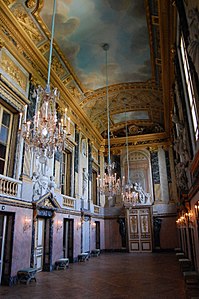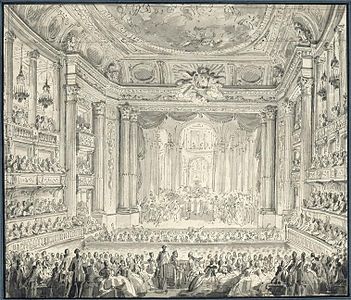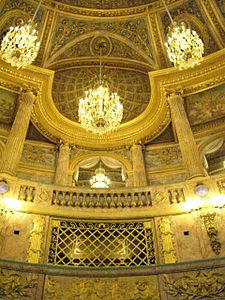Ange-Jacques Gabriel
Ange-Jacques Gabriel | |
|---|---|
 Ange Jacques Gabriel by Jean-Baptiste Greuze | |
| Born | 23 October 1698 |
| Died | 4 January 1782 (aged 83) Paris, France |
| Occupation | Architect |
| Parent | Jacques Gabriel |
Ange-Jacques Gabriel (French pronunciation:
Biography
Early life and career
Ange-Jacques Gabriel was born on 23 October 1698, to a famous Parisian family of architects, and was connected by marriage with another celebrated architect of the time,
In his new position, he served under the supervision of two successive Directors of the Buildings of the King, Tournehem and Abel-François Poisson, the Marquis de Marigny, the brother of the King's mistress and cultural advisor, Madame de Pompadour.[1]
Place Louis XV (now Place de la Concorde)
-
The Place Louis XV in about 1775
The Place Louis XV, today's
Ecole Militaire
-
Gabriel's plan for the Ecole Militaire
-
TheEcole Militaire
-
Chapel of Saint Louis
Louis XV decided in 1751 to create the
The Petit Trianon
-
West facade of the Petit Trianon
-
Aerial view of the Petit Trianon and its small park
At the request of
Royal Opera of Versailles
-
Foyer of the Royal Opera
-
The Royal Opera during the celebration of the marriage of Louis XVI and Marie-Antoinette (1770)
-
Royal box
-
Stage of the Royal Opera
Much of his attention was devoted to modifications of the Palace of Versailles desired by Louis XV. The palace lacked a proper opera theater; a theater had been commanded under Louis XIV in 1682 for the end of the North Wing but the project had been put on hold due to its cost of the King's wars and the complexity of meeting the needs of the Court. Gabriel made a new proposal for the same site in 1748, but it was also put on hold due to the cost. occupied himself with numerous modifications to the exterior of the Palace, notably the completion and extension of the North Wing, following closely the original designs of Mansard, completed in 1764.[5]
The Opera project was revived in 1765 and was accelerated in 1770 for the celebrations of the marriage of the Dauphin, the future
Death
His final projects were the completion of the facades of the buildings he designed for the Place de la Concorde; the former Hôtel de Coislin, and the
Style
His sober rationality in planning and detail promoted the transition from Rococo to Neoclasscism. He was not especially known for boldness or originality; borrowing extensively from the French classicism and early classical models, particularly from the Louvre. He was known for his craftsmanship, his ability to balance the animation of the Baroque style with the more restrained neoclassicism, the proportions and balance and careful detail of his buildings, and his ability to create dramatic and harmonious ensembles of monumental buildings, as he did in the Place de la Concorde. [4]
Major works


- Place de la Bourse, Bordeaux, 1730–1775, begun by his father, after 1740 completed by Gabriel
- Extension and transformations at the Château de Choisy, 1740–1777
- Château de Compiègne, 1750 onwards
- The Pavillon du Butard, 1750 at La Celle-Saint-Cloud.
- Place de la Bourse, Bordeaux, 1755 (as Place Royale)
- Extension of the Château de Menars (Loir-et-Cher), 1760–1764, for Madame de Pompadour
- Petit Trianon, at Versailles, 1762 to 1768
- L'École Militaireon the Champ de Mars, Paris
- L'Opéra at the Château de Versailles, 1769–70
- Place de la Concorde (as Place Louis XV), 1772
- Hôtel de la Marine, Place de la Concorde, 1775
- Hôtel de Crillon, Place de la Concorde
See also
- Neoclassicism in France
- Louis Quinze
Notes
- ^ a b c Gallet 1999, pp. 256–57.
- ^ Gallet 1999, pp. 257–258.
- ^ Gallet 1999, pp. 259–260.
- ^ a b Gallet 1999, p. 264.
- ^ a b Saule 2013, p. 60.
Bibliography
- Braham, Allan (1980). The Architecture of the French Enlightenment. Berkeley: University of California Press. pp. 38–44. ISBN 9780520067394.
- Gallet, Michel (1999). "Anges Jacques Gabriel". Dictionnaire des Architectes. Paris: Encyclopaedia Universalis. pp. 256–264. ISBN 2-226-10952-8.
- Gallet, Michel; Bottineau, Yves (1982). Les Gabriel. Paris: Picard. ISBN 9782708400863..
- Gallet, Michel (1995). Les architectes parisiens du XVIIIe siècle: dictionnaire biographique et critique. Paris: Editions Mengès. pp. 212–224. ISBN 9782856203705.
- Kalnein, Wend von (1995). Architecture in France in the Eighteenth Century'. New Haven: Yale University Press. pp. 145–160. ISBN 9780300060133.
- Saule, Beatrix (2013). Versailles - The Chateau, the gardens, the Trianons. Paris: Art Lys. ISBN 9782711873395.
- Tadgell, Christopher (1978). Ange-Jacques Gabriel. London: A. Zwemmer. ISBN 9780302027813.
- Tadgell, Christopher (1982). "Gabriel, Ange Jacques". In Placzek, Adolf K. (ed.). Macmillan Encyclopedia of Architects. Vol. 2. London: The Free Press. pp. 133–144. ISBN 9780029250006.
- Tadgell, Christopher (1996). "Gabriel: (3) Ange-Jacques Gabriel". In Turner, Jane (ed.). ISBN 9781884446009.. Also at Oxford Art Online(subscription required).
External links
- Ange-Jacques Gabriel at Great Buildings Online











